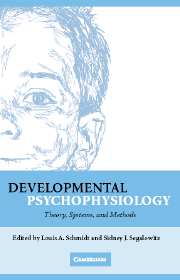Book contents
- Frontmatter
- Contents
- Foreword by Stephen W. Porges
- Preface
- Acknowledgments
- Contributors
- 1 Capturing the Dynamic Endophenotype: A Developmental Psychophysiological Manifesto
- SECTION ONE CENTRAL SYSTEM: THEORY, METHODS, AND MEASURES
- SECTION TWO AUTONOMIC AND PERIPHERAL SYSTEMS: THEORY, METHODS, AND MEASURES
- SECTION THREE NEUROENDOCRINE SYSTEM: THEORY, METHODS, AND MEASURES
- 11 Emotion, Temperament, Vulnerability, and Development: Evidence from Nonhuman Primate Models
- 12 Neuroendocrine Measures in Developmental Research
- SECTION FOUR DATA ACQUISITION, REDUCTION, ANALYSIS, AND INTERPRETATION: CONSIDERATIONS AND CAVEATS
- Index
- References
11 - Emotion, Temperament, Vulnerability, and Development: Evidence from Nonhuman Primate Models
from SECTION THREE - NEUROENDOCRINE SYSTEM: THEORY, METHODS, AND MEASURES
Published online by Cambridge University Press: 27 July 2009
- Frontmatter
- Contents
- Foreword by Stephen W. Porges
- Preface
- Acknowledgments
- Contributors
- 1 Capturing the Dynamic Endophenotype: A Developmental Psychophysiological Manifesto
- SECTION ONE CENTRAL SYSTEM: THEORY, METHODS, AND MEASURES
- SECTION TWO AUTONOMIC AND PERIPHERAL SYSTEMS: THEORY, METHODS, AND MEASURES
- SECTION THREE NEUROENDOCRINE SYSTEM: THEORY, METHODS, AND MEASURES
- 11 Emotion, Temperament, Vulnerability, and Development: Evidence from Nonhuman Primate Models
- 12 Neuroendocrine Measures in Developmental Research
- SECTION FOUR DATA ACQUISITION, REDUCTION, ANALYSIS, AND INTERPRETATION: CONSIDERATIONS AND CAVEATS
- Index
- References
Summary
INTRODUCTION
Nonhuman primates provide the opportunity to study the development of emotional behavior, temperament, and vulnerability to psychiatric disorders under controlled conditions. Like humans, these animals display temperamental variability (Byrne & Suomi, 2002; Higley & Suomi, 1989). Manipulation of prenatal and early life environments influence behavioral, cognitive/emotional, and physiological variables in monkeys and environmental variables continue to affect these domains in adulthood. This finding has implications for vulnerability to conditions such as anxiety disorders, depression, and alcoholism in humans. Alterations in early life experience, subsequent behavioral patterns, and neuroendocrine activity are associated with anatomical and functional changes in brain regions implicated in emotional behavior and psychopathology. Linking variables observed during early development with long-term mental health outcomes in adulthood is an area of research in which nonhuman primate studies can contribute important knowledge.
A great advantage of nonhuman primate research is the ability to investigate developmental hypotheses that cannot be studied in human children. First, the ability to manipulate the environment and tightly control that environment is an advantage of nonhuman primate research. Also, procedures are possible with nonhuman primates that are too invasive and therefore anxiety-provoking or even dangerous for human children. For example, measuring plasma concentrations of substances like cortisol requires blood samples; measurement of neuropeptide or neurotransmitter metabolite concentrations requires a lumbar puncture in order to extract cerebral spinal fluid (CSF) samples. Therefore, nonhuman primates provide a way of investigating environmental effects on these types of biological variables.
Information
- Type
- Chapter
- Information
- Developmental PsychophysiologyTheory, Systems, and Methods, pp. 319 - 342Publisher: Cambridge University PressPrint publication year: 2007
